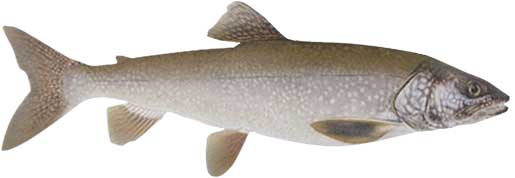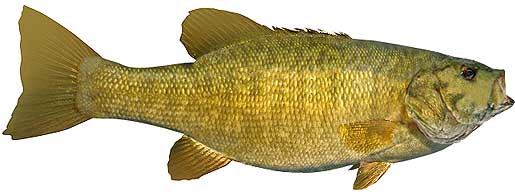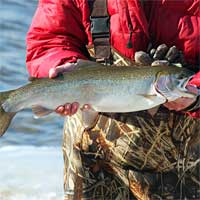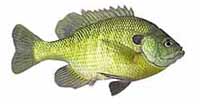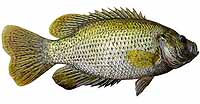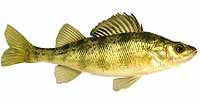Fishing Report For Seneca Lake, NY
By Rick Seaman
Last updated on .
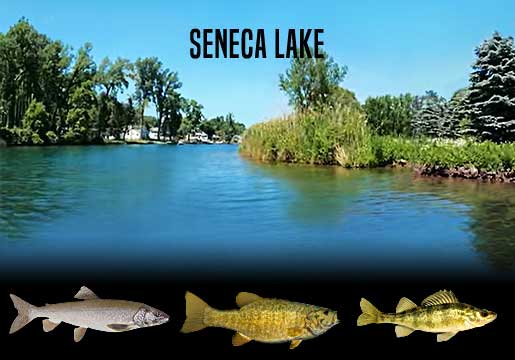
Fishing Reports
Popular Fish Species Seneca Lake, NY
Lake Trout
Current Report: Good To Very Good
Lake trout are very popular at Seneca Lake. Many call this the lake trout capital of the world. Every Memorial Day, the National Lake Trout Derby is held, with cash prizes for various categories. Locals report that the middle third of the lake has the best population of lakers.
FALL. Lake trout are returning to relatively shallow water, as Fall weather cools the lake. They spawn in the Fall, and for a few weeks can typically be found 40 to 120 feet deep on points, flats and humps that have a rocky bottom. The area from Sampson State Park to Lodi Point State Marine Park is popular in Fall, especially out in front of Long Point. Lake trout feed on small fish, so lures imitating baitfish, sunfish, perch or small trout are good choices. Cloudy days, early mornings and early evenings are the best time to catch big lakers. Later in Fall they return to 60 to 200 feet deep, or deeper. Spoons, jigged vertically within the target depth can entice bites. Trolling with spoons, brightly-colored jerkbaits, and spinners with a variety of rigging methods to get these lures to run deep. For big lakers, use larger baits.
WINTER. While much of the lake freezes in Winter, it is not consistently safe, so most anglers wait until ice out, and troll. Favoring water temperatures in the 40's, lake trout find areas to their liking in 60 to 200 feet of water, and tend to stay there throughout the cold months. A good number of lake trout are holding in the deep basin troughs, and along the main channel. Learning these areas before the lake ices over can get you into some of the better area for ice fishing. Patient anglers willing to work slowly are catching some nice lake limits through the ice. After ice out, trolling with leaded line or downriggers, or vertical jigging with spoons and jigs, completes the cold-water season in 80 to 250 feet of water, or deeper.
SPRING. Prime laker fishing season is during Spring. Spring weather finds lake trout, along with baitfish, into 30 to 80 feet of water. Early Spring is a prime time to catch big lakers. Lakers are caught in areas of the lake which have deep water next to shallower, feeding spots. Jigs and heavy spoons are catching the majority of these big lakers. Vertical jigging with spoons, or slow trolling with leaded line or downriggers in deeper water, also produces some nice fish. Later in Spring they typically drop into 60 to 100 feet of water.
SUMMER. Summer heat drives lake trout deeper, generally below the thermocline in 100 to 300 feet deep. Early and late in the day, lakers may feed as shallow as 70 feet deep. Generally, lake trout prefer to stay deep, near the thermocline throughout Summer. They look for depth variations like ditches, channels, humps and ledges, but are being caught in the deeper water around this structure. Heavy spoons and jigs, as well as very slow trolling, with leaded line or downriggers, produce many of the lakers being caught during Summer.
Smallmouth Bass
Current Report: Good
Local bass enthusiasts report good catches in the section of the lake from Seneca Lake State Park to the area around Yale. This lake is considered a good smallmouth bass fishery, with plenty of fish in the 3 lb to 5 lb range.
FALL. Fall is in full swing and smallmouth have followed schools of baitfish into coves and bays 6 to 20 feet deep. They thrive in the cold, clean water, which is an ideal environment for them. Points and rocky banks around Lodi Point State Marine Park, Sampson State Park, and the Glen Eldridge area are popular smallie hangouts. Locals report that tube jigs are a great choice when the bass are around 15 feet deep. Drop shot rigs with small worms or shad shaped plastics are also popular in 10' water or deeper. Jerkbaits, deep-diving crankbaits, and slow-rolled spinnerbaits, are also successful, when bass are shallow to mid depth. Later in Fall, smallies move to slightly deeper water, around 10 to 30 feet deep. Fishing shallow for smallmouth is often good on cold, windy, cloudy and rainy days.
WINTER. Winter will isolate them around deeper structure, points, flats and creek channels, often suspending in open water above these features. They can generally be found from 20 to 40 feet deep. Ice fishing is somewhat popular, but mostly for other species. Jigging spoons, tube baits, drop-shot worms, jigs and Ned rigs temp smallmouth in deep water. After ice out, I like to work these deeper haunts very slowly, as the bass are somewhat sluggish. Here they hold, feeding less frequently, awaiting warmer water to return in Spring.
SPRING. When water temperatures rise into the 50's, smallmouth move from deep wintering spots to shallower water, just outside spawning areas. Points, rip rap and rocky banks around Long Point, Lodi Point State Marine Park, and the Glen Eldridge area are good spawn areas for smallmouth. They feed heavily in 2 to 12 feet of water at this time, and are typically caught on jerkbaits, crankbaits, tube baits, Ned rigs, and crayfish imitating plastics. Once water warms into the high 50's, they move into shallower water, and create nests in gravel or sand areas, then lay their eggs. Females then move to deeper water and males remain to guard the eggs, and then the fry. After a couple weeks, the males also move into 8 to 15 feet deep, and feed aggressively. Crankbaits, tube baits, Ned rigs, plastic worms, spoons and swimbaits are catching smallies during this period.
SUMMER. Smallmouth bass are currently feeding shallow early and late in the day in 8 to 25 feet of water. They are being caught on crankbaits, swimbaits, Ned rigs and tube baits. Smallmouth bass here feed on crawfish, gizzard shad, and small sunfish. They prefer rocky or gravel bottom areas, as this is where crayfish live. During the hotter parts of the day, they are being caught on points, humps, and ledges around 15 to 30 feet deep. Often these deeper fish tend to school, so finding them can deliver some fast action.
Yellow Perch
Current Report: Very Good
Reported by many to be the "best yellow perch fishing lake", of all the finger lakes, Seneca Lake is churning out lots of quality perch these days. These tasty fish-fry candidates provide anglers with great table fare, and are a steady food source for larger, predator fish.
FALL. As Fall is working its way toward Winter, anglers are finding yellow perch feeding aggressively in 20 to 45 feet of water, especially around weed lines and drop offs, Points and rocky banks around Sampson State Park, Lodi Point State Marine Park, and Glass Factory Bay are popular areas for good perch fishing. Later in the Fall, they begin migrating toward Winter holding areas, often in the deeper sections around the deeper edges of weedbeds, drop offs along flats, channel edges, and humps. Minnows, spinners, spoons and crankbaits are ideal this time of year.
WINTER. The cold of winter drives perch deeper again in search of food and stable water conditions. Ice fishing is possible in some areas, some years, but open-water fishing is most popular and productive. Areas around tributaries and inflowing creeks are ideal Winter holding spots. Perch are also being caught when they are feeding in weedy areas, in 35 to 75 of water. Good catches are being reported using minnows, spoons, and jigs tipped with nightcrawlers.
SPRING. Perch spawn in Spring when the water temperature warms to the mid 50's and mid 60's. Anglers are beginning to catch them in 2 to 12 feet of water using minnows, mealworms, maggots, and nightcrawlers. Docks, weed lines, drop offs all attract yellow perch searching for a meal. Later in Spring, they drop into 10 to 14 feet of water. Coves in the small bays north of Lodi have historically delivered nice stringers of perch.
SUMMER. Fat yellow perch here feed primarily on small fish and invertebrates. Spinners, underspins, small crankbaits, mealworms, nightcrawlers and maggots are popular for catching perch in 12 to 35 feet of water. In early Summer, plus the first and last hours of the day ,seek them out in feeding zones, 6 to 12 feet deep. Drop-offs, and in areas with submerged vegetation, are key feeding spots..
Fishing Video
Fish species to fish for...
Guide to fishing for largemouth bass, smallmouth bass, rainbow trout, brown trout, lake trout, bluegill, pumpkinseed sunfish, rock bass, yellow perch, landlocked salmon (Atlantic salmon) and northern pike at Seneca Lake in New York.
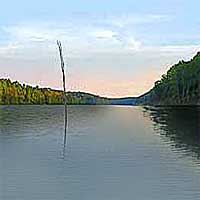 Seneca Lake is a 43,000-acre lake with well over 100 miles of shoreline, is considered by many to be the lake trout capital of the world. Healthy populations of rainbow trout, brown trout, smallmouth bass, largemouth bass, northern pike, landlocked salmon, yellow perch, bluegill and pumpkinseed all reside here in good numbers.
Seneca Lake is a 43,000-acre lake with well over 100 miles of shoreline, is considered by many to be the lake trout capital of the world. Healthy populations of rainbow trout, brown trout, smallmouth bass, largemouth bass, northern pike, landlocked salmon, yellow perch, bluegill and pumpkinseed all reside here in good numbers.
Primary fish species to catch
Click images for fishing tips and details about each species.
Today's Weather & Forecast
Fishing Boat Rentals
Click here for fishing boat rentals.
Public Boat Launch Ramps & Landings
Click here for boat ramps.
Marinas
Click here for marinas.
Fishing License
Click here for a New York Fishing License.
Map - Fishing & Access
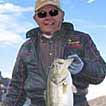 Rick Seaman is a fishing enthusiast with over five decades of fishing experience, a retired tournament fisherman, author of numerous published articles on fishing, and co-author of the book "Bass Fishing - It's not WHAT you throw, It's WHERE you throw it".
Rick Seaman is a fishing enthusiast with over five decades of fishing experience, a retired tournament fisherman, author of numerous published articles on fishing, and co-author of the book "Bass Fishing - It's not WHAT you throw, It's WHERE you throw it".
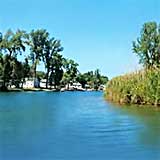 Contact Information
Contact Information
Sampson State Park Marina
6096 Route 96A
Romulus, NY 14541
315 585-6392
Fishing lakes in each state
111025
Seneca Lake, New York Report
NEW YORK


Information about fishing lakes in New York
Fishing for bass, trout, sunfish, perch, salmon and pike at Seneca Lake in central NY.


